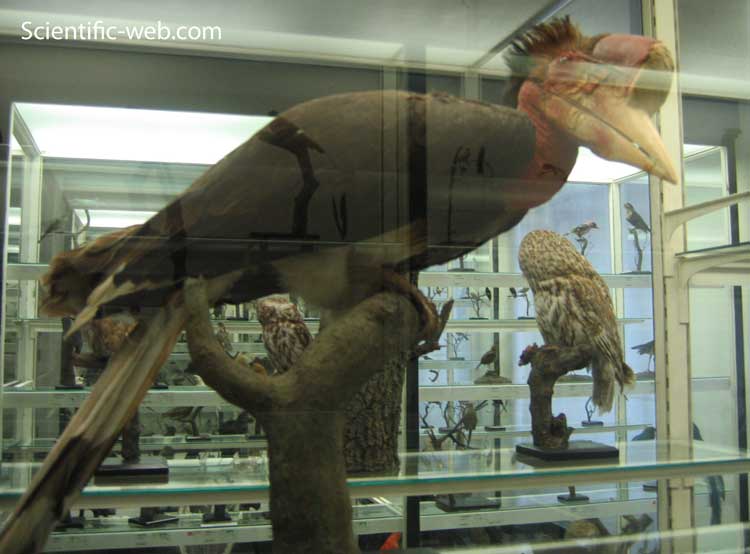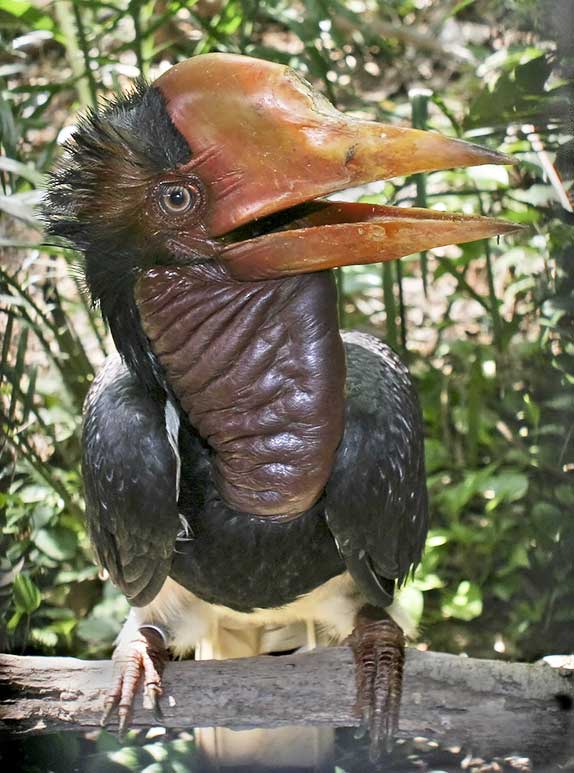
Helmeted Hornbill, Rhinoplax vigil, Photo: Michael Lahanas
Superregnum: Eukaryota
Cladus: Unikonta
Cladus: Opisthokonta
Cladus: Holozoa
Regnum: Animalia
Subregnum: Eumetazoa
Cladus: Bilateria
Cladus: Nephrozoa
Superphylum: Deuterostomia
Phylum: Chordata
Subphylum: Vertebrata
Infraphylum: Gnathostomata
Megaclassis: Osteichthyes
Cladus: Sarcopterygii
Cladus: Rhipidistia
Cladus: Tetrapodomorpha
Cladus: Eotetrapodiformes
Cladus: Elpistostegalia
Superclassis: Tetrapoda
Cladus: Reptiliomorpha
Cladus: Amniota
Classis: Reptilia
Cladus: Eureptilia
Cladus: Romeriida
Subclassis: Diapsida
Cladus: Sauria
Infraclassis: Archosauromorpha
Cladus: Crurotarsi
Divisio: Archosauria
Cladus: Avemetatarsalia
Cladus: Ornithodira
Subtaxon: Dinosauromorpha
Cladus: Dinosauriformes
Cladus: Dracohors
Cladus: Dinosauria
Ordo: Saurischia
Cladus: Eusaurischia
Subordo: Theropoda
Cladus: Neotheropoda
Cladus: Averostra
Cladus: Tetanurae
Cladus: Avetheropoda
Cladus: Coelurosauria
Cladus: Tyrannoraptora
Cladus: Maniraptoromorpha
Cladus: Maniraptoriformes
Cladus: Maniraptora
Cladus: Pennaraptora
Cladus: Paraves
Cladus: Eumaniraptora
Cladus: Avialae
Infraclassis: Aves
Cladus: Euavialae
Cladus: Avebrevicauda
Cladus: Pygostylia
Cladus: Ornithothoraces
Cladus: Ornithuromorpha
Cladus: Carinatae
Parvclassis: Neornithes
Cohors: Neognathae
Cladus: Neoaves
Ordo: Bucerotiformes
Familia: Bucerotidae
Genus: Rhinoplax
Species: Rhinoplax vigil
Name
Rhinoplax vigil (JR Forster, 1781)
Synonymy
Buceros vigil (protonym)

Rhinoplax vigil (*)
References
Indische Zoologie p. 40
IUCN: Rhinoplax vigil (Critically Endangered)
Vernacular names
български: Шлемоносна птица носорог
বাংলা: হেলমেটওয়ালা ধনেশ
català: Calau de gorgera
čeština: Zoborožec štítnatý
Cymraeg: Cornbig helmog
Deutsch: Schildschnabel
Ελληνικά: Ρινόπλαξ
English: Helmeted Hornbill
Esperanto: Kaska bucero
español: Cálao de yelmo
فارسی: نوکشاخ کلاهخوددار
suomi: Naurusarvinokka
français: Calao à casque rond
עברית: קלאו חום-ציצית
magyar: Kalapácsfejű szarvascsőrű
Bahasa Indonesia: Rangkong gading
lietuvių: Šalmuotasis kalao
മലയാളം: ഹെൽമറ്റെഡ് ഹോൺബിൽ
Bahasa Melayu: Burung Enggang Tebang Mentua
Nederlands: Helmneushoornvogel
norsk: Hjelmhornfugl
Diné bizaad: Tsídiidaantsxaaí bítááʼ ntłʼizígíí
русский: Шлемоносная птица-носорог
svenska: Hjälmnäshornsfågel
ไทย: นกชนหิน
Tiếng Việt: Hồng hoàng mũ cát
The helmeted hornbill (Rhinoplax vigil) is a very large bird in the hornbill family. It is found on the Malay Peninsula, Sumatra, Borneo, Thailand and Myanmar. The casque (helmetlike structure on the head) accounts for some 11% of its 3 kg weight. Unlike any other hornbill, the casque is almost solid, and is used in head-to-head combat among males.[3] It is a belief among the Punan Bah that a large helmeted hornbill guards the river between life and death.[4]
Description
Borneo Rainforest Lodge - Danum Valley - Sabah, Borneo - Malaysia
It has mostly blackish plumage, except that the belly and legs are white and the tail is white with a black band near the tip of each feather. The tail is long and the two central tail feathers are much longer than the others, giving the bird a total length greater than that of any other hornbill species. The body length is 110–120 cm (43–47 in), not counting the tail feathers, which boost the length a further 50 cm (20 in). One male weighed 3.1 kg (6.8 lb) in weight while two females averaged about 2.7 kg (6.0 lb). Although sometimes considered the largest Asian hornbill, their body weight appears to be similar to that of the great hornbill (and considerably less than the African ground hornbills).[5][6]
This species has a bare, wrinkled throat patch, pale blue to greenish in females and red in males. The casque goes from the base of the bill halfway to the tip, where it ends abruptly. It and the bill are yellow; the red secretion of the preen gland covers the sides and top of the casque and the base of the bill, but often leaves the front end of the casque and the distal half of the bill yellow. Unlike other hornbills, the helmeted hornbill's casque is solid, and the skull including the casque and bill may constitute 10 percent of the bird's weight.
Call
The call is a series of loud, intermittent barbet-like hoots, sometimes double-toned and over two dozen in number, which gradually accelerates to culminate in a cackle reminiscent of laughter.
Habits
Painting of a helmeted hornbill in flight
Illustration of a mature male bird, distinguishable its casque shape and red throat area
Helmeted hornbills mostly eat the fruit of strangler figs. The birds breed once a year, producing a single chick. Mother and chick live inside a sealed tree cavity for the first five months of the chick's life. Males fight over territory on the wing, ramming each other with their casques.[7] Such encounters are called aerial jousting. Females accompany males during an approach in an aerial joust but veer off in opposite directions during the collision.[8]
Status
After ongoing hunting pressure and habitat loss, the helmeted hornbill was uplisted from near threatened to critically endangered on the IUCN Red List of Threatened Species in 2015. It is listed in Appendix I of CITES. According to the conservation group TRAFFIC, 2,170 casques were confiscated in just three years in China and Indonesia alone.[9] There are fewer than 100 birds remaining in Thai forests. At least 546 hornbill parts, mostly casques of helmeted hornbills, have been posted for sale on Thai Facebook in the past five years. Traders will pay villagers 5,000-6,000 baht (US$165–200) for a hornbill head. Prices double or triple in cities and increase exponentially when sold overseas.[10]
Ivory casque
19th-century Japanese belt ornament in hornbill ivory, showing natural preen gland colouring
The casque is the source of hornbill ivory, a valuable carving material. Indigenous peoples also use the central tail feathers to decorate dancing cloaks and head-dresses. Historically, the casque was also used by carvers in China and Japan.[11][12]
References
BirdLife International (2020). "Rhinoplax vigil". IUCN Red List of Threatened Species. 2020: e.T22682464A184587039. doi:10.2305/IUCN.UK.2020-3.RLTS.T22682464A184587039.en. Retrieved 19 November 2021.
"Appendices | CITES". cites.org. Retrieved 2022-01-14.
"The bird that's more valuable than ivory". Magazine. BBC News. 12 October 2015. Retrieved 19 October 2015.
[1] Archived February 4, 2012, at the Wayback Machine
"Helmeted hornbill videos, photos and facts – Rhinoplax vigil". arkive.org. Archived from the original on 2012-04-16. Retrieved 2012-05-03.
Dunning, John B. Jr., ed. (2008). CRC Handbook of Avian Body Masses (2nd ed.). CRC Press. ISBN 978-1-4200-6444-5.
Bale, Rachael (September 2018). "Poached for Its Horn, This Rare Bird Struggles to Survive". National Geographic. Retrieved 20 April 2020.
Kinnaird, Margaret; Hadiprakarsa, Yokyok; Thiensongrusamee, Preeda (2003). "Aerial jousting by Helmeted Hornbills Rhinoplax vigil: Observations from Indonesia and Thailand". Ibis. 145 (3): 506–508. doi:10.1046/j.1474-919X.2003.00188.x.
"Helmeted Hornbills - Species we work with at TRAFFIC". www.traffic.org. Retrieved 2019-01-10.
Sivasomboon, Busaba (11 October 2019). "Better protection sought for Thailand's helmeted hornbill". Minneapolis Star Tribune. Associated Press. Retrieved 12 October 2019.
BBC Magazine (12 Oct 2015). "The bird that's more valuable than ivory". BBC. Retrieved 13 Oct 2015.
Cammann, Schuyler V. R. (1950). "The story of hornbill ivory". Museum Bulletin (Penn Museum). 15 (4): 19–47.
Further reading
Perrins, Christopher (ed.) (2003). Firefly Encyclopedia of Birds. Firefly Books. ISBN 1-55297-777-3. {{cite book}}: |author= has generic name (help)
Kemp, Allen (1994). Hornbills: Bucerotidae. Oxford University Press. ISBN 0-19-857729-X. Quoted at [2] Archived 2009-03-01 at the Wayback Machine
Retrieved from "http://en.wikipedia.org/"
All text is available under the terms of the GNU Free Documentation License

